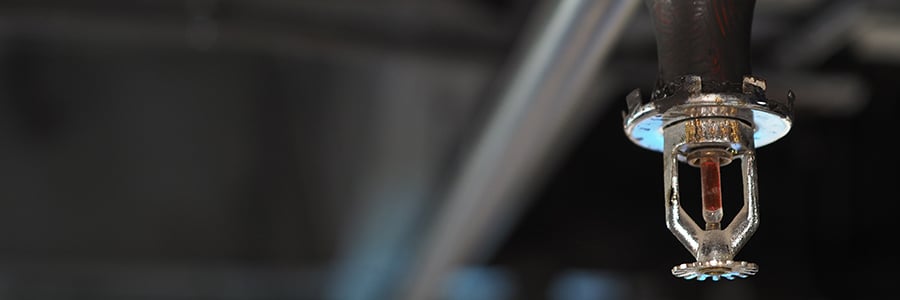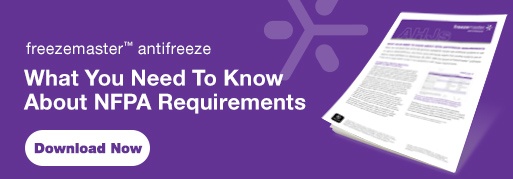
By: Mark Knurek on September 27th, 2019
Fire Sprinkler System Antifreeze Dangers Led to NFPA 25 Revisions
Codes, Standards & Approvals | Temperature
NFPA 25 is the standard for the inspection, testing and maintenance of water-based fire protection systems. Once adopted by local code bodies, authorities having jurisdiction (AHJs) require strict adherence to NFPA 25 – and frankly, there is no reason not to design, repair or maintain a system to the standard.
The standard is updated on a regular basis, with the most recent edition published in 2020. In 2014, NFPA published emergency changes regarding the use of antifreeze. Let’s take a look into the background of what prompted this requirement and why it is so important to use a listed antifreeze.
Water-filled pipes for fire sprinkler systems, such as those made of metal or CPVC, must remain above 40° F (4.44° C) to prevent freezing that can cause severe damage, leaks or pressure drops. Glycerin and propylene glycol-based antifreeze solutions had been the industry standards for many years to prevent freezing, thus allowing the systems to protect lives and property despite severe cold, particularly in northern climates. While both are combustible agents, they have been used effectively as long as the proportion mixed with water was at levels prescribed by the manufacturer and permitted by NFPA 13.
That way of thinking changed forever when a 2009 cooking fire was intensified – rather than suppressed – by a sprinkler system equipped with glycerin-based antifreeze, killing a young mother and injuring her husband and three children. The antifreeze concentration was extremely high, estimated at 71.2 percent, causing the fire to virtually explode. The news of this fire caused NFPA to begin studying the use of antifreeze for fire protection and issue the first public notice warning about its use in July of 2010.
A 2001 New Jersey resort fire was described similarly, with injuries to 16 people. An excessive proportion of propylene glycol-based antifreeze in the sprinkler protection system was the presumed cause.
In both instances, the high concentration of antifreeze solutions was likely caused by improper mixing on-site when installed in the fire sprinkler system.
NFPA and UL Research Results in New Standards for Antifreeze
Following the 2009 fire, NFPA and Underwriters Laboratories (UL) conducted extensive research that showed certain concentrations of antifreeze would actually intensify a fire.
Based on the research, UL established standard UL 2901 in December 2013. The standard outlines requirements for the performance of antifreeze solutions for wet fire sprinkler systems. To meet the UL 2901 requirements, antifreeze products must prove corrosion resistance (important for metal-based fire sprinkler systems), fire performance (i.e., flammability - an especially challenging performance requirement to meet), low conductivity levels, hydraulic characteristics, human health and environmental impact, and meet marking and installation specifications.
Following the establishment of UL 2901, in January 2014, the NFPA enacted emergency changes to NFPA 25, Inspection, Testing and Maintenance of Water-Based Fire Protection Systems, regarding the use of antifreeze solutions. The revisions were based on the earlier NFPA/UL research and UL 2901. Bottom line, NFPA requirements states that all new antifreeze systems must use a premixed, agency listed antifreeze solution, which addresses the life safety issues associated with antifreeze use.
Exceptions to this include glycerin and propylene glycol (aka, traditional) antifreeze products used in installed sprinkler systems prior to September 30, 2012, where one of the following conditions is met and documented:
- The concentration of the antifreeze solution shall be limited to 30% propylene glycol and to 38% glycerin by volume or
- Antifreeze systems with concentrations in excess of 30% but not more than 40% propylene glycol by volume and 38% but not more than 50% glycerin by volume shall be permitted where approved by the AHJ or
- The continued use of factory premixed propylene glycol in excess of 30% by volume for early suppression, fast response (ESFR) systems, where the ESFR sprinklers are listed for such use in a specific application (i.e., systems installed in warehouses in place of in-rack systems)
These limits make it difficult to use these products in colder climates as they do not provide the freeze protection performance required. In any case, they may no longer be used after September 29, 2022. After this date, these products must be replaced by listed products.
Stringent standards and annual testing methods were also established for existing systems, allowing specific levels of factory premixed antifreeze solutions. These levels varied among NFPA 13, NFPA 13D and NFPA 13R systems.
One term of which to take note in all of the NFPA revisions: the use of factory premixed antifreeze solutions. The factory premixed requirement takes the guesswork and potential risk out of onsite mixing.
freezemasterTM Antifreeze For All Wet Fire Sprinkler Systems
Lubrizol Advanced Materials, a specialty company with more than 30 years of fire safety expertise, is proud to announce the availability of freezemasterTM antifreeze, a safe to use, UL-listed, factory premixed, FBC™ System Compatible antifreeze that can be installed and serviced in all new and existing fire sprinkler systems for Residential, Light Hazard, Ordinary Hazard and Storage applications to help meet requirements for NFPA 13, 13R, 13D and 25, including at volumes up to 500 gallons for NFPA 13 (Light Hazard) systems. (Refer to the freezemasterTM antifreeze Installation Guide for design parameters and listing limitations.)
freezemasterTM antifreeze delivers the safety, performance and assurance you can rely on in temperatures as low as -12°F (-24°C). It is:
- Formulated with a superior corrosion inhibitor compared to listed alternatives, effectively reducing pipe corrosion by 65%
- Dyed blue for easy identification of a fully flushed and filled system, saving installers from having to constantly test a clear fluid
- Backed by a team of product specialists that is on call to provide onsite and technical support
Make sure your business and customers are protected against costly corrosion and the severe cold. Subscribe today to our blog to stay up-to-date with the latest industry and product information.



